Architecture diagram using Visio Stencils

In the previous post, I emphasised on how much a picture can communicate than words. In order to draw good Architecture diagrams using Visio, first we need the proper stencils. The following stencils would be handy for any Architecture diagrams using Visio. Office Stencils Microsoft Azure, Cloud and Enterprise Symbol / Icon Set Azure Reference Architectures Microsoft Integration Stencil Pack Exchange 2013 Stencil SOA Stencils (from Arcitura) ( Symbol Legend ) Cloud Computing Stencils (from Arcitura) ( Symbol Legend )
